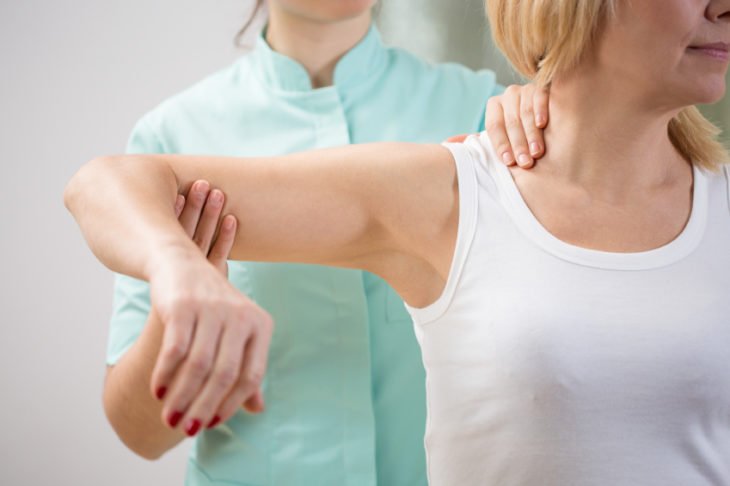Why do so many women experience mediocre, or even painful sex? It seems to be a plaguing female issue that never gets solved despite the vast and varied avenues you may have pursued—yoga, therapy, food, sex positions you didn’t even know existed. Here’s one you probably haven’t considered: Alexander Technique. An effective self-care method for improving poor postural habits that may be causing you unnecessary stress, tension, or pain, Alexander takes a mind-body approach to how you move. Apply this to how you get it on, and you just might find that you’re experiencing greater climaxes, multiple orgasms, or pain-free sex.
We talked with Rachel Bernsen, a nationally certified teacher of the Alexander Technique. Here, she gives you a rundown on what it is, some ideas for practicing on your own, and suggested sex positions (they’re simpler than you think).

Source: Harvard Health – Harvard University
The Frisky: In a general nutshell, what does Alexander Technique hope to accomplish?
Rachel Bernsen: Lessons in the Alexander Technique teach students how to recognize and undo potentially harmful physical habits, ease chronic pain or discomfort, decrease stress levels, and positively effect your overall health. By becoming more engaged in how you physically do something, you can learn new ways of going through everyday activities with much less muscular effort.
The Frisky: How can studying Alexander improve your sexual experiences? Can you give some concrete examples of benefits one might achieve?
RB: You can definitely improve your sex life through Alexander—benefits include a greater receptivity to pleasure and comfort throughout your whole body, a fuller experience of orgasm, and the ability to have multiple orgasms. To get there, you have to start with the mind. When you’re focused only on the orgasm (or even worrying about not having one), you’ll probably experience anxiety, which can contribute to excess holding patterns in the form of over-contracted buttock, groin, and abdominal muscles. We often don’t know we’re holding so much tension there. We can’t always feel it, but becoming aware of these habits are an important first step to letting them go. I have one student, a 30-something woman, who reported that she’d never been able to have multiple orgasms, but after studying Alexander, experiences this very often. Another, in her mid-40s, told me she now has increased overall pleasure during sex since studying the technique.
The Frisky: Wow. So, we’re kinda ashamed to ask, but all this relaxing business makes us wonder about opening up to anal sex …
RB: Yes, you can apply the same principles. For those daunted by anal sex, this can also be improved by the release of over-contracted anus and buttock muscles, a letting-go that can also alleviate low back pain and minimize the symptoms of sciatica and even hemorrhoids. Think “free your butt.”
The Frisky: OK, can you walk us through some Alexander Techniques that we can try on our own?
RB:
- Spend some time each day letting go. Lie on your back on a hard surface with a gently elevated firm support for your head. Have one or both knees bent, feet on the floor. Keep your eyes open and be aware of the space around you. Give your back a chance to let go, especially your rib cage, lower back and pelvis. Allow your pelvis and shoulder blades to be heavy on the floor. Don’t try to straighten your spine, instead think about its curves. (An anatomical diagram of the skeleton could be helpful here). Imagine your tailbone uncurling like a fiddle-head fern toward your heels. Check in with your neck muscles and invite them to do less work to hold up your head. A firm support, such as books, can help ease your head into a more supported place. It’s surprising how little time we give ourselves to really do nothing. Even just 5-15 minutes a day can help ease tension.
- Start paying attention to how you walk and sit. Here’s something to think about: When I’m walking or sitting I sometimes imagine that the space between my legs all the way up to my pelvic floor is an upside down U shape, instead of an upside down V shape. That helps create more space between my legs and eases tension in my groin and inner thighs.
- This is not directly from the Alexander Technique but I often bring it up with my students: Be aware of overly contracted abdominal muscles. They can play a big role in restricting freedom in your hips and groin and contribute to the overly common pelvic tucking that is NOT to be desired. Work your abs intelligently and do not over do it. Remember that your abdominals wrap around the bottom half of your torso like a girdle, they are not flat like a washboard. So, don’t just focus on your six-pack, it’ll do nothing for you in bed!
The Frisky: So what about when you’re actually having sex—are there any positions advocated for achieving more comfort during sex?
RB: One Alexander teacher, Deborah Caplan, talks about pain free sex positions in her book Back Trouble, A New Approach to Prevention and Recovery. She stresses the importance of having hips and knees bent in order to protect your back during intercourse if you suffer from back pain or are recovering from a back injury. In the missionary position, she recommends sleeping-size pillows be placed under the person on the bottom, elevating them to a level where the person on top can be on their hands and knees. She also recommends spooning, which is a folded position for both partners, and therefore easy on the back.
Original by Leonora Epstein
